CloudApper hrPad simplifies employee classification with automated timekeeping, shift management, geofencing, and AI assistance. It ensures FLSA compliance, reduces HR workload, and enhances transparency, empowering employees while preventing costly misclassification errors. Streamline HR processes and improve workforce efficiency with hrPad.
Table of Contents
Employee classification plays a crucial role in defining an organization’s workforce and ensuring compliance with labor laws. It involves accurately categorizing workers into different classifications based on their job roles, compensation, work hours, and benefits. However, maintaining accurate employee classifications can be a complex and time-consuming process for HR teams. Misclassifying employees can lead to significant legal and financial consequences. Fortunately, modern tools like employee self-service kiosks are helping organizations simplify employee classification and reduce administrative burdens.
For more information on CloudApper hrPad visit our page here.
CloudApper hrPad, an employee self-service kiosk, offers a robust solution that streamlines the classification process, ensuring compliance with labor laws while enhancing operational efficiency. In this article, we will explore how self-service kiosks like hrPad can simplify employee classification and the role they play in adhering to classification rules such as those outlined by the Fair Labor Standards Act (FLSA).
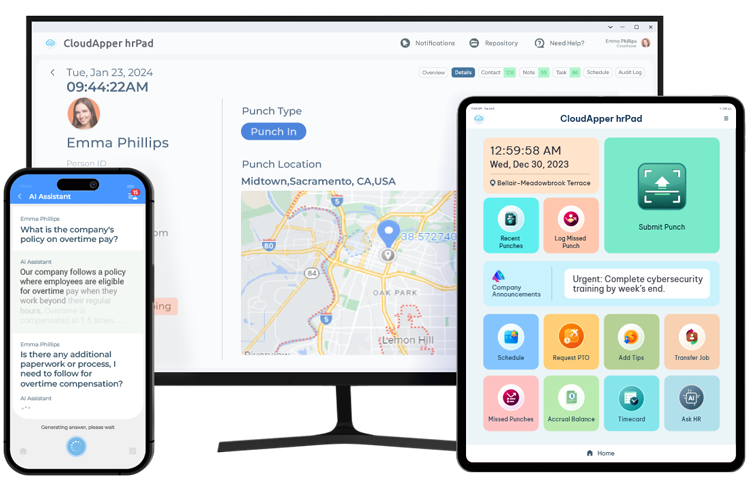
What Are Exempt and Non-Exempt Employees?
To understand the impact of accurate classification, it’s important to first define two key categories of employees under the FLSA:
- Exempt Employees: These employees are exempt from the FLSA’s overtime pay requirements. This typically includes salaried employees in executive, administrative, professional, or outside sales roles. Exempt employees are paid a fixed salary regardless of the number of hours worked, and they are not entitled to overtime compensation for hours worked over 40 hours in a workweek.
- Non-Exempt Employees: In contrast, non-exempt employees are entitled to receive overtime pay for hours worked over 40 in a workweek. Non-exempt employees are generally paid on an hourly basis, and the FLSA mandates that they receive 1.5 times their regular hourly rate for overtime work.
The classification between exempt and non-exempt employees is vital for determining overtime pay, salary calculations, and ensuring compliance with federal and state labor laws. Misclassifying employees can result in costly fines, back pay claims, and even lawsuits.
FLSA Overtime Rule:
The FLSA overtime rule is a key aspect of employee classification that affects how non-exempt employees are compensated. According to the FLSA, non-exempt employees must receive overtime pay for any hours worked over 40 hours in a workweek. The rate of overtime pay is typically 1.5 times the employee’s regular hourly wage.
For example, if a non-exempt employee works 45 hours in a week and their regular pay rate is $15 per hour, they are entitled to 5 hours of overtime at a rate of $22.50 per hour (1.5 times their regular pay rate). Exempt employees, on the other hand, are not entitled to overtime pay, regardless of how many hours they work.
The FLSA has specific criteria for determining whether an employee qualifies as exempt or non-exempt, including factors such as job duties, salary level, and salary basis. This makes it essential for employers to accurately classify their employees to avoid potential violations of overtime rules.
How Employee Self-Service Kiosks Simplify Employee Classification:
CloudApper hrPad serves as a powerful employee self-service kiosk that can simplify the employee classification process while ensuring compliance with labor laws, including the FLSA overtime rule. Here’s how hrPad’s features support accurate classification:
- Automated Timekeeping and Overtime Calculation: hrPad ensures accurate time tracking for all employees, whether exempt or non-exempt. The kiosk’s automated timekeeping system tracks employee hours and calculates overtime based on pre-configured rules. This ensures that non-exempt employees are paid correctly for overtime work, avoiding costly payroll mistakes and ensuring compliance with FLSA overtime requirements.
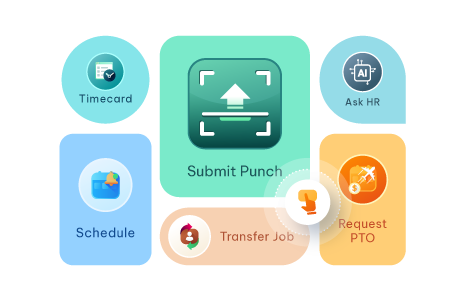
- Customizable Time Capture: hrPad allows businesses to configure time tracking based on their specific policies and employee classifications. Organizations can tailor the system to ensure accurate timekeeping for both exempt and non-exempt employees, helping to prevent errors that could lead to misclassification or non-compliance.
- Shift Management and Classification: For employees who work in varying roles or schedules, hrPad’s shift management tools help classify employees according to their job type, whether they’re exempt or non-exempt. Employees can self-manage their shifts, request time off, and even bid or swap shifts—all of which contribute to simplifying the classification process. These features make it easier for HR teams to track who is working and ensure proper classifications.
- Geofencing for Accurate Location Tracking: hrPad’s geofencing feature ensures that employees are working within authorized locations, which is especially useful for businesses with multiple job sites. Geofencing also helps determine the eligibility of employees for specific pay categories, such as hourly versus salaried classifications, providing a seamless experience for both employees and HR teams.
- Real-Time Data Syncing with HR Systems: One of the standout features of CloudApper hrPad is its ability to integrate seamlessly with popular HR systems, such as UKG, Workday, ADP, and more. This ensures that employee classifications, timekeeping data, and overtime calculations are synchronized in real time across platforms, providing HR teams with a unified and up-to-date view of their workforce.
- AI Assistance for Policy Enforcement: The built-in AI assistant in hrPad helps employees and HR teams alike. The AI can answer common HR questions about classification, overtime, and policies, ensuring that employees have accurate information about their status as exempt or non-exempt. The AI also ensures that employee queries about their classification are addressed efficiently, reducing confusion and HR workload.
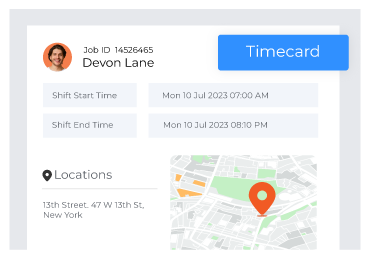
Benefits for Employers and Employees:
- For Employers:
- Legal Compliance: Automating employee classification and overtime calculations with hrPad helps ensure compliance with the FLSA and other labor laws. This reduces the risk of costly fines and lawsuits.
- Operational Efficiency: By streamlining timekeeping, classification, and payroll processes, hrPad saves HR teams significant time, allowing them to focus on more strategic tasks.
- Cost Savings: Automation reduces errors and improves payroll accuracy, leading to savings by avoiding overpayments, penalties, and fines.
- For Employees:
- Transparency: Employees have access to real-time data about their classifications, hours worked, and overtime, promoting a transparent and positive work environment.
- Empowerment: The self-service kiosk enables employees to manage their schedules, request time off, and check their pay information, putting control in their hands.
Conclusion:
Accurate employee classification is essential for compliance with labor laws and the fair treatment of employees. Misclassifying employees, especially in regard to exempt and non-exempt status, can lead to costly legal consequences. CloudApper hrPad’s employee self-service kiosk simplifies the classification process by automating timekeeping, enforcing overtime rules, and providing HR teams with a streamlined solution for managing employee data. With its powerful AI tools and seamless integration with HR systems, hrPad ensures that organizations can efficiently manage employee classifications while reducing administrative overhead and promoting a transparent and efficient workforce.
Explore how CloudApper hrPad can transform your employee classification process and help you stay compliant with labor laws. Visit our website to learn more about how our AI-powered employee self-service kiosk can simplify your HR workflows and improve your employee experience.
What is CloudApper AI Platform?
CloudApper AI is an advanced platform that enables organizations to integrate AI into their existing enterprise systems effortlessly, without the need for technical expertise, costly development, or upgrading the underlying infrastructure. By transforming legacy systems into AI-capable solutions, CloudApper allows companies to harness the power of Generative AI quickly and efficiently. This approach has been successfully implemented with leading systems like UKG, Workday, Oracle, Paradox, Amazon AWS Bedrock and can be applied across various industries, helping businesses enhance productivity, automate processes, and gain deeper insights without the usual complexities. With CloudApper AI, you can start experiencing the transformative benefits of AI today. Learn More
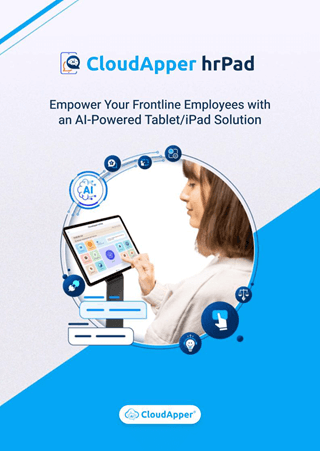
Brochure
CloudApper hrPad
Empower Frontline Employees with an AI-Powered Tablet/iPad Solution
Download Brochure
CloudApper AI Solutions for HR

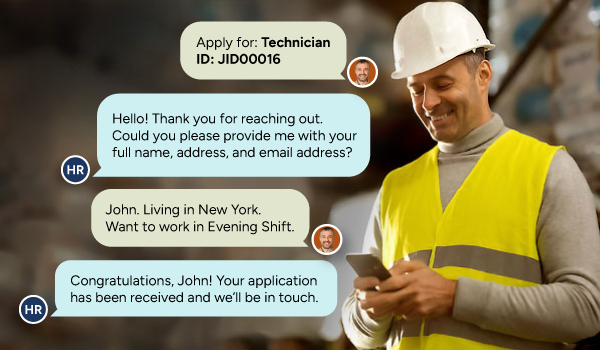

- Works with








- and more.
Similar Posts

5 Best Practices for Empowering MSP Contingent Workforce with CloudApper…

Expert Insights on the Future of Federal Workforce Management with…






